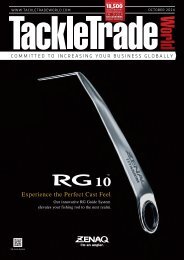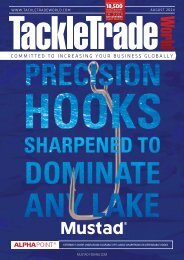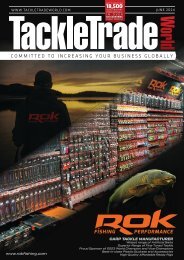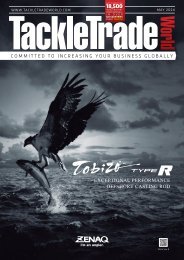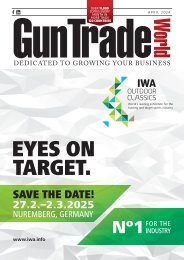You also want an ePaper? Increase the reach of your titles
YUMPU automatically turns print PDFs into web optimized ePapers that Google loves.
TENTS SECTOR SPOTLIGHT<br />
Photo: Patrick Hendry (Unsplash)<br />
▲ In the warmer months, many adventure-style tents can be used without a flysheet, further increasing their portability.<br />
TRENDING<br />
The trends on display in the<br />
tent camping market do vary<br />
quite considerably depending on<br />
which corner of the Earth you<br />
reside. In European countries<br />
like the UK, France, the<br />
Netherlands, and Germany, the<br />
largest part of the market is for<br />
good-sized family tents. Think<br />
anything from a four-person<br />
tent through to a 10-person<br />
tent, most of which nowadays<br />
feature inflatable tubes rather<br />
than traditional poles. This is<br />
probably down to the fact that<br />
families want to enjoy a much<br />
higher level of luxury than they<br />
once did on a camping trip, and<br />
the industry has responded in<br />
kind. It’s not uncommon for a<br />
large, multi-bedroom tent to be<br />
sold with a solid collection of<br />
furniture such as chairs, tables,<br />
carpets, wardrobes and more.<br />
This kind of camping normally<br />
sees families staying on one<br />
site for a prolonged period of a<br />
week or longer. In other nations,<br />
such as North America, while<br />
these larger family tents do have<br />
a place, smaller backpacking<br />
style tents tend to dominate the<br />
industry a little more. Besides<br />
cultural differences, a lot of<br />
this could also be attributed<br />
to the kinds of places people<br />
go camping. In Europe, welldeveloped<br />
campsites with good<br />
facilities and plenty of space<br />
for leisure vehicles mean that<br />
larger family tents are suited.<br />
In North America, it is much<br />
easier to go camping in the<br />
wilderness and not on a specific<br />
campground. This is partly down<br />
to access issues and also to the<br />
large amount of space North<br />
America has geographically.<br />
The backpacking or lightweight<br />
camping tent market is seeing<br />
some growth in Europe though,<br />
possibly down to a growing<br />
interest in the great outdoors<br />
from the general public and also<br />
driven by inspirational content<br />
provided on social media.<br />
You could be mistaken for<br />
thinking that a growth in<br />
family-sized tents would mean<br />
less of a focus on technical<br />
materials. In fact, the demand<br />
from consumers for their tent<br />
to be a proper home from home<br />
means that manufacturers are<br />
putting in more effort than<br />
ever to come up with more<br />
advanced technical materials<br />
that are also environmentally<br />
friendly. In Europe, Danish<br />
family camping brand Outwell<br />
recently revealed one of its most<br />
durable and protective materials<br />
ever, Outtex 6000 Endurance<br />
RS, while over in the United<br />
States, New Hampshire-based<br />
Nemo Equipment revealed<br />
an award-winning new fabric<br />
technology, OSMO, that scores<br />
well on the sustainability scale.<br />
The increasing demand for<br />
smarter technology is evident:<br />
a tent that doesn’t display any<br />
effort to have some kind of<br />
advanced technology within<br />
its construction will likely not<br />
be a huge hit with consumers.<br />
Equally important is that<br />
eco message. Consumers are<br />
becoming more environmentally<br />
savvy in general, but campers<br />
are perhaps even more so than<br />
50 | www.campingtradeworld.com




